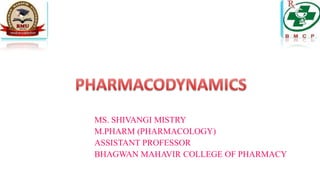
Pharmacodynemics
- 1. MS. SHIVANGI MISTRY M.PHARM (PHARMACOLOGY) ASSISTANT PROFESSOR BHAGWAN MAHAVIR COLLEGE OF PHARMACY
- 2. MECHANISM OF DRUG ACTION • Drug action : Drug action is the initial interaction of a drug with cells at the site of action & the resultant physiological & biochemical consequences are the drug effect. • Majority of drugs produce their effect by interacting with a discrete target biochemolecule, which usually is protein . • Protein that are targets of drug action can be grouped into four major categories : 1. Enzyme 2. Ion channel 3. Transporters 4. Receptor
- 3. 1. ENZYME
- 4. • Drugs can either increase or decrease the rate of enzymatically mediated reactions. • Enzyme stimulation : it is increase affinity for the substrate . • enzyme stimulation is relevant to some natural metabolites only , e.g. pyridoxine acts as a co- factor & increase decarboxylase activity. • Several enzyme are stimulated through receptor & second messenger, e.g. adrenaline stimulates hepatic glycogen phosphorylase through beta- receptor & second messenger. • Enzyme inhibition : • (A) Non-specific inhibition : They alter the tertiary structure of any enzyme with which they come in contact & thus inhibit it. • E.g. Heavy metal salts, strong acid & alkalies, alcohol, formaldehyde, phenol.
- 5. • (B) specific inhibition : (a) competitive inhibition : • Equilibrium type : The drug being structurally similar with the normal substrate for catalytic binding site of enzyme so that the product is not formed or non-functional product is formed. • E.g . - physostigmine & neostigmine compete with Ach for cholinesteras. - sulfonamide compete with PABA for bacterial folate synthetase. • Non-equilibrium type : it’s type of enzyme inhibition can also occur with drug which react with same catalytic site of enzyme but either form strong covalent bonds or have such high affinity for enzyme that normal substrate is not able to displace the inhibition. • E.g. - Organophosphate react covalently with esteretic site of the enzyme cholinesteras. - Methotrexate has 50,000 time higher affinity for dihydrofolate reductase than normal substrate DHFA.
- 6. • (b) Non-competitive : The inhibitor reacts with adjacent & not with catalytic site, but alter enzyme in such a way that it loses it’s catalytic property. • E.g - Omeprazole :- H+ k+ ATPase. - Digoxin :- Na+ K+ ATPase. • 2. ION CHANNEL : • Protein which acts as ion selective channels participate in transmembrane signaling & regulate intracellular ionic composition. • Drugs can affect ion channel either through specific receptor ( ligand gated ion channels, G- protein operated ion channels) or by directly binding channels & affecting ion movement. • E.g. - quinine block myocardial Na+ channel. - dofetilide & amiodarone bolck myocardial delayed rectifier K+ channels.
- 9. 3. TRANSPORTERS : • Several substrate are translocated across membrane by binding to specific transporters. • Many drugs produce their action by directly interacting with carrier of transpoter protein to inhibit going physiological transport of metabolites. • E.g. - amphetamine selectively block dopamine reuptake in Brian neurons by vesicular amine transporter. - reserpine block granular reuptake of noradrenaline & 5-HT by vesicular amine transporter.
- 10. 4. RECEPTOR
- 13. • (A) Receptor occupation theory : Clark (1937) propounded theory of drug action based on occupation of receptor by specific drugs & that pace of cellular function can be altered by interaction of receptor with drug. • Agonist :- it’s have both affinity & max. intrinsic activity. - E.g. adrenaline, histamine, morphine. • Competitive antagonist :- it’s have affinity but no intrinsic activity. - E.g. propranolol, atropine. • Partial agonist :- it’s have affinity & submax. Intrinsic activity. - E.g. pentazocine. • Inverse agonist :- it’s have affinity but negative intrinsic activity. - E.g. benzodiazepine receptor.
- 14. (B) The two-state receptor model :- • The receptor is believed to exit in two interchangeable state : Ra(active) & Ri(inactive) which are in equilibrium.
- 16. (C) NATURE OF RECEPTOR :
- 17. (D) RECEPTOR SUBTYPE :
- 18. RELATIONSHIP BETWEEN DRUG CONC. & EFFECT :